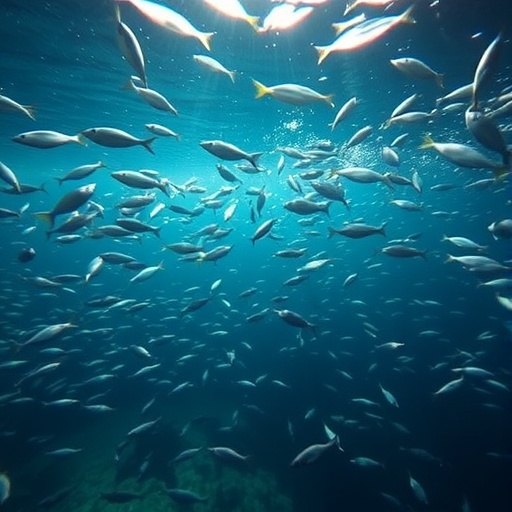The Dynamic Transformation of Marine Ecosystems in Kosterhavet National Park: Harnessing AI to Decode Long-Term Ecological Change
The delicate balance of marine ecosystems is constantly influenced by both natural and anthropogenic factors. In the Kosterhavet National Park, located in the Swedish marine environment, recent decades have witnessed significant shifts in species composition and habitat structures. A pioneering study by researchers at the University of Gothenburg has leveraged cutting-edge machine learning techniques to unravel these long-term ecological changes, providing unprecedented insights into the responses of marine communities to conservation measures and climate dynamics.
Historically, trawling practices in Kosterhavet disrupted benthic habitats, severely impacting not only commercially significant fish and shellfish but also foundational species such as anemones and corals. The implementation of stringent trawling restrictions over the past quarter-century has offered a unique natural experiment, allowing scientists to observe the cascading effects of reduced physical disturbance on seabed communities. This protective intervention, combined with the region’s gradual warming waters, sets the stage for an intricate ecological narrative that unfolds beneath the waves.
Central to this research was the extraordinary archive of underwater footage accumulated since 1997 at a steep rock wall within the Koster Sea. Captured using remotely operated underwater vehicles (ROVs), this visual repository documents nearly three decades of benthic life with varying degrees of clarity and complexity. The sheer volume of imagery—totaling approximately 4.4 million frames—posed an insurmountable analytical challenge until the advent of advanced computational models capable of automated species recognition.
At the forefront of this technological approach was the application of deep learning-based object detection algorithms. Developed and refined by master’s student Christian Nilsson under the guidance of marine ecologist Matthias Obst, the AI system was trained to distinguish 17 distinct benthic species, ranging from sessile filter feeders to structurally critical habitat-forming organisms. Training the model involved painstaking annotation of representative images and iterative optimization to achieve reliable accuracy across diverse environmental conditions and image qualities.
The utilization of Sweden’s National Academic Infrastructure for Supercomputers (NAISS) enabled the rapid processing of this vast dataset, transforming what would have been years of manual labor into a task accomplished within mere hours. This computational power facilitated the extraction of robust temporal trends, revealing nuanced shifts in species abundance and distribution over the course of 26 years. The data illuminated not only the positive effects of trawling cessation but also pronounced declines linked to rising seawater temperatures.
Filter-feeding organisms such as mussels, anemones, and soft corals exhibited notable recovery trajectories once the physical disturbances from trawling were eliminated. These species are integral to marine ecosystems due to their roles in nutrient cycling and providing complex habitats that support biodiversity. Their resurgence underlines the resilience of benthic communities when anthropogenic pressures are alleviated, demonstrating the efficacy of marine protected areas in fostering ecosystem restoration.
Conversely, the study documented stark decreases in large and thermally sensitive species inhabiting shallower zones of the Koster Fjord. The football sponge (Geodia barretti) faced the most significant decline, with populations dwindling to near local extinction levels. Similarly, the excavated fileclam (Acesta excavata), vital as a habitat engineer, gradually disappeared. These trends are indicative of warming waters exacerbating habitat loss for species adapted to cooler, stable temperature regimes.
This divergence in species trajectories spotlights the dual influence of conservation efforts and climate change, prompting complex management challenges. While protection against direct human impacts yields measurable ecosystem benefits, indirect stressors such as ocean warming can negate or overshadow these gains. The study’s fine-scale temporal resolution facilitates early detection of such climate-driven shifts, enabling proactive conservation strategies tailored to evolving environmental contexts.
The integration of deep learning into marine ecology heralds a new era of data-driven environmental monitoring. The successful automated identification and quantification of benthic species from massive video archives demonstrate the transformative potential of AI in addressing data bottlenecks inherent in long-term ecological research. This methodological advancement sets a precedent for similar applications across diverse marine and terrestrial ecosystems.
Moreover, the study’s findings contribute significantly to the European Union’s Digital Twin of the Ocean (DTO) initiative, which seeks to model real-time ecosystem dynamics to inform sustainable ocean governance. By merging empirical data with predictive computational frameworks, the research exemplifies how interdisciplinary collaborations between ecology and computer science can enhance understanding and stewardship of marine resources under rapidly changing global conditions.
Looking forward, the research team emphasizes the necessity of identifying refugia in deeper, cooler waters to conserve species adversely affected by warming surface temperatures. Such habitat shifts may become increasingly common, demanding adaptive management approaches that transcend traditional spatial boundaries of protected areas. This dynamic perspective underscores the importance of incorporating climate resilience into marine conservation planning.
In summary, the convergence of long-term ecological data and advanced AI modeling has unveiled complex patterns of recovery and decline within the Kosterhavet marine ecosystem. The study not only validates the benefits of trawling restrictions but also illuminates the looming challenges posed by climate change. This comprehensive understanding equips policymakers and scientists with the knowledge required to implement more effective, forward-thinking conservation strategies that safeguard marine biodiversity for future generations.
Subject of Research: Not applicable
Article Title: Applying Deep Learning to Quantify Drivers of Long-Term Ecological Change in a Swedish Marine Protected Area
News Publication Date: 2-Sep-2025
Web References:
http://dx.doi.org/10.1002/ece3.72091
Image Credits: University of Gothenburg
Keywords: Kosterhavet National Park, marine ecosystem, trawling restrictions, deep learning, AI, benthic species, long-term ecological monitoring, marine protected area, climate change, digital twin of the ocean, underwater video analysis, habitat recovery




